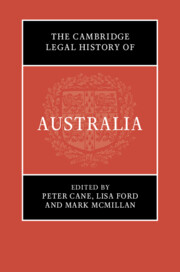Book contents
- The Cambridge Legal History of Australia
- The Cambridge Legal History of Australia
- Copyright page
- Contents
- Figures
- Maps
- Contributors
- Maps
- 1 Editors’ Introduction
- I Cultures of Law
- II Public Authority
- III Public Authorities in Encounter
- IV Land and Environment
- V Social Organisation
- VI Social Ordering
- 25 Criminal Law and the Administration of Justice in Early New South Wales and Van Diemen’s Land
- 26 Criminal Justice after the Convicts: A History of the Long Twentieth Century
- 27 Indigenous Peoples and Settler Criminal Law
- 28 Civil Wrongs
- 29 Labour Law
- 30 Place and Race in Australian Copyright Law: May Gibbs’s and Albert Namatjira’s Copyright
- VII Reckonings
- Index
26 - Criminal Justice after the Convicts: A History of the Long Twentieth Century
from VI - Social Ordering
Published online by Cambridge University Press: 04 August 2022
- The Cambridge Legal History of Australia
- The Cambridge Legal History of Australia
- Copyright page
- Contents
- Figures
- Maps
- Contributors
- Maps
- 1 Editors’ Introduction
- I Cultures of Law
- II Public Authority
- III Public Authorities in Encounter
- IV Land and Environment
- V Social Organisation
- VI Social Ordering
- 25 Criminal Law and the Administration of Justice in Early New South Wales and Van Diemen’s Land
- 26 Criminal Justice after the Convicts: A History of the Long Twentieth Century
- 27 Indigenous Peoples and Settler Criminal Law
- 28 Civil Wrongs
- 29 Labour Law
- 30 Place and Race in Australian Copyright Law: May Gibbs’s and Albert Namatjira’s Copyright
- VII Reckonings
- Index
Summary
Australian histories of twentieth-century criminal justice systems have been under-researched. This chapter offers a corrective, outlining the changing character and focus of twentieth-century century criminal justice institutions and pointing their on-going effects today. Major changes included a vast expansion of police power and technological capacity, and an investigative focus on individual criminal’s identities, history and rehabilitative potential. The criminal trial was transformed by procedural changes that led to an extraordinary expansion of guilty pleas, so much so that trials now form a very small part of the justice process. The focus of higher courts shifted to sentencing determinations, where imprisonment or alternatives were weighed up by judges after receiving sentencing submissions of growing complexity. Despite constant evidence against its effectiveness, the twentieth century cemented the prison as a major institution of state power. Changes meant victims of crime had less legal power and standing, although the justice system continued to rely substantially on victim reports to respond to crime.
- Type
- Chapter
- Information
- The Cambridge Legal History of Australia , pp. 605 - 628Publisher: Cambridge University PressPrint publication year: 2022



